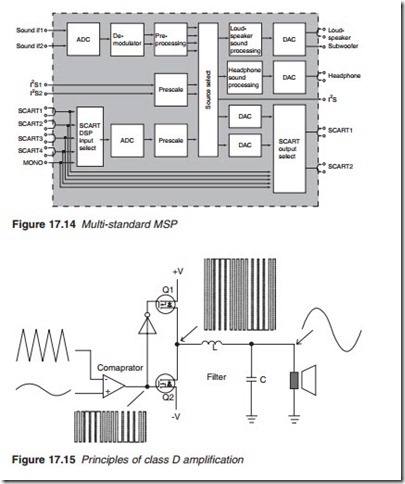Multi-sound processor
Demodulation and decoding of NICAM sound is incorporated in a single IC package known as a multi-sound processor (MSP; Figure 17.12). SIF goes into the FM demodulator to produce the normal mono sound which is fed into L and R loudspeakers. NICAM inter-carrier IF is extracted and fed into the NICAM decoder which carries out all necessary functions to retrieve the L/R stereo sound, which following DAC is fed into the appropriate L/R amplifiers and subsequently to the speakers.
In practice, there are several sources of audio including stereophonic audio from an in-built DVB decoder. A sound selector is therefore necessary as shown in Figure 17.13. The audio switch is controlled by an I2C bus to select a particular sound output. The MSP carries out all necessary demodulation of inter-carriers and decoding of NICAM sound. The output of the MSP is fed into a dual audio amplifier on its way to the loudspeakers.
Multi-standard MSP
Modern MSPs are multi-standard processing chips covering sound process- ing of all analogue TV standards (PAL, NTSC, SEACAM) as well as NICAM (Figure 17.14). Automatic sound selection is incorporated within the pack- age together with automatic volume correction (AVC) to avoid annoying vol- ume changes when the sound source changes. Different sound sources (e.g. terrestrial channels, SAT channels or SCART) fairly often do not have the same volume level. Advertisements during movies usually have a higher volume level than the movie itself. The automatic volume correction solves this problem by equalising the volume level. Processing is fully digital and analogue inputs including SIF and SCART inputs are fed into an ADC before demodulation and processing and subsequently converted back to analogue audio (mono, stereo or multi-channel).


